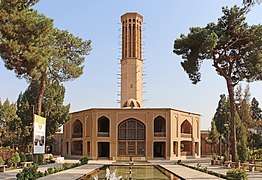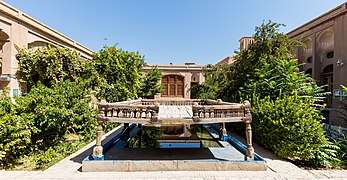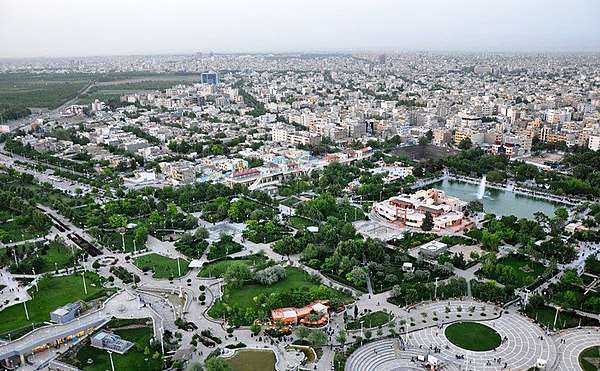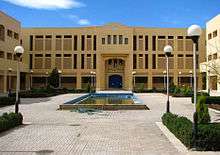Yazd
| Yazd یزد | ||
|---|---|---|
| City | ||
 Top to bottom: Amir Chakhmaq Complex, Yazd Fire Temple | ||
| ||
 Yazd | ||
| Coordinates: 31°53′50″N 54°22′4″E / 31.89722°N 54.36778°ECoordinates: 31°53′50″N 54°22′4″E / 31.89722°N 54.36778°E | ||
| Country |
| |
| Province | Yazd | |
| County | Yazd | |
| Bakhsh | Central | |
| Government | ||
| • Mayor | Mehdi Jamalinejad[1] | |
| • City Council Chairman | Gholam Ali Sefid | |
| Elevation | 1,216 m (3,990 ft) | |
| Population (2016 Census) | ||
| • Urban | 529,673 [2] | |
| Demonym(s) | Yazdi (en) | |
| Time zone | UTC+3:30 (IRST) | |
| • Summer (DST) | UTC+4:30 (IRDT) | |
| Area code(s) | 035 | |
| Climate | BWh | |
| Website |
yazd | |
| Official name | Historic City of Yazd | |
| Type | Cultural | |
| Criteria | iii, v | |
| Designated | 2017 (41st session) | |
| Reference no. | 1544 | |
| State Party | Iran | |
| Region | Asia and the Pacific | |
Yazd (یزد, ![]()
Because of generations of adaptations to its desert surroundings, Yazd has a unique Persian architecture. It is nicknamed the "City of Windcatchers" (شهر بادگیرها Shahr-e Badgirha) from its many examples. It is also very well known for its Zoroastrian fire temples, ab anbars (cisterns), qanats (underground channels), yakhchals (coolers), Persian handicrafts, handwoven cloth (Persian termeh), silk weaving, Persian Cotton Candy, and its time-honored confectioneries.
History
The name is derived from Yazdegerd I, a Sassanid ruler of Persia. The city was definitely a Zoroastrian center during Sassanid times. The word yazd means God.[7] After the Arab conquest of Iran, many Zoroastrians migrated to Yazd from neighboring provinces. By paying a levy, Yazd was allowed to remain Zoroastrian even after its conquest, and Islam only gradually became the dominant religion in the city.
Because of its remote desert location and the difficulty of access, Yazd remained largely immune to large battles and the destruction and ravages of war. For instance, it was a haven for those fleeing from destruction in other parts of Persian Empire during the Mongol invasion. In 1272 it was visited by Marco Polo, who remarked on the city's fine silk-weaving industry. In the book The Travels of Marco Polo, he described Yazd in the following way:
It is a good and noble city, and has a great amount of trade. They weave there quantities of a certain silk tissue known as Yasdi, which merchants carry into many quarters to dispose of. When you leave this city to travel further, you ride for seven days over great plains, finding harbour to receive you at three places only. There are many fine woods producing dates upon the way, such as one can easily ride through; and in them there is great sport to be had in hunting and hawking, there being partridges and quails and abundance of other game, so that the merchants who pass that way have plenty of diversion. There are also wild asses, handsome creatures. At the end of those seven marches over the plain, you come to a fine kingdom which is called Kerman.
Yazd briefly served as the capital of the Muzaffarid Dynasty in the fourteenth century, and was unsuccessfully besieged in 1350–1351 by the Injuids under Shaikh Abu Ishaq. The Friday (or Congregation) mosque, arguably the city's greatest architectural landmark, as well as other important buildings, date to this period. During the Qajar dynasty (18th century AD) it was ruled by the Bakhtiari Khans.
Under the rule of the Safavid (16th century), some people migrated from Yazd and settled in an area that is today on the Iran-Afghanistan border. The settlement, which was named Yazdi, was located in what is now Farah City in the province of the same name in Afghanistan. Even today, people from this area speak with an accent very similar to that of the people of Yazd.
One of the notable things about Yazd is its family-centered culture. According to official statistics from Iran's National Organization for Civil Registration, Yazd is among the three cities with the lowest divorce rates in Iran.
Demographics
Language and ethnic groups
The majority of the people of Yazd are Persians, and they speak Persian with Yazdi accent different from Persian accent of Tehran.
Religion
The majority of people in Yazd are Muslims. There is also a sizable population of Zoroastrians in the city. In 2013, Sepanta Niknam was elected to the city council of Yazd and became the first Zoroastrian councillor in Iran.[8] There was once a relatively large Jewish-Yazdi community, however, after the creation of Israel, many have moved there for varying reasons. Former president of Israel Moshe Katsav is an example.
The Pir-e-Naraki[9] sanctuary is one the important pilgrimage destinations for Zoroastrians where an annual congregation is held and frequent visits are made during the year; it is now also a famous tourist spot.
The story of the last Persian prince to come to Yazd before the arrival of Islam adds to its importance. Such a transformation has occurred several times.[10]
Several other city traditions are the Muslim parades and gatherings, which are mainly processions called azadari held to commemorate the events experienced by the main Islamic martyrs and other important figures. These huge public gatherings created a series of spaces which, since most are near important urban monuments, are used at other times as hubs from which visitors can tour the main spots in the city .[11]
Population
According to the Iranian Census of 2011 the population of Yazd is 486,152 people from 168,528 families, which includes 297,546 men and 285,136 women.[12]
Historical sites

Yazd is an important centre of Persian architecture. Because of its climate, it has one of the largest networks of qanats in the world, and Yazdi qanat makers are considered the most skilled in Iran.
To deal with the extremely hot summers, many old buildings in Yazd have magnificent wind towers and large underground areas.
The city is also home to prime examples of yakhchals, which were used to store ice retrieved from glaciers in the nearby mountains. Yazd is also one of the largest cities built almost entirely out of adobe.
Yazd's heritage as a center of Zoroastrianism is also important. There is a Tower of Silence on the outskirts, and the city has an ateshkadeh which holds a fire that has been kept alight continuously since 470 AD. Zoroastrians make up a significant minority of the population, around 20,000–40,000 or 5 to 10 percent.
Built in 12th century and still in use, Jame Mosque of Yazd is an example of the finest Persian mosaics and excellent architecture. Its minarets are the highest in the country.
Geography
Climate
Yazd is the driest major city in Iran, with a yearly precipitation amount of 49 millimetres (1.9 in) and only 23 days of precipitation, which is also the hottest city north of the Persian Gulf coast, with summer temperatures very frequently above 40 °C (104 °F) in blazing sunshine with no humidity. Even at night the temperatures in summer are rather uncomfortable. In the winter, the days remain mild and sunny, but in the morning the thin air and low cloudiness cause cold temperatures that can sometimes fall well below 0 °C (32 °F).
| Climate data for Yazd | |||||||||||||
|---|---|---|---|---|---|---|---|---|---|---|---|---|---|
| Month | Jan | Feb | Mar | Apr | May | Jun | Jul | Aug | Sep | Oct | Nov | Dec | Year |
| Record high °C (°F) | 27.0 (80.6) |
28.0 (82.4) |
32.0 (89.6) |
37.0 (98.6) |
41.0 (105.8) |
44.0 (111.2) |
45.0 (113) |
45.6 (114.1) |
42.0 (107.6) |
36.0 (96.8) |
30.0 (86) |
27.4 (81.3) |
45.6 (114.1) |
| Average high °C (°F) | 12.9 (55.2) |
15.9 (60.6) |
20.6 (69.1) |
26.0 (78.8) |
32.2 (90) |
37.2 (99) |
39.6 (103.3) |
38.1 (100.6) |
34.0 (93.2) |
27.6 (81.7) |
19.3 (66.7) |
14.0 (57.2) |
26.5 (79.6) |
| Daily mean °C (°F) | 6.3 (43.3) |
9.0 (48.2) |
13.8 (56.8) |
18.7 (65.7) |
24.5 (76.1) |
29.4 (84.9) |
31.7 (89.1) |
29.9 (85.8) |
25.4 (77.7) |
19.3 (66.7) |
11.7 (53.1) |
6.9 (44.4) |
18.9 (66) |
| Average low °C (°F) | −0.3 (31.5) |
2.2 (36) |
7.0 (44.6) |
11.5 (52.7) |
16.8 (62.2) |
21.7 (71.1) |
23.8 (74.8) |
21.8 (71.2) |
16.9 (62.4) |
11.0 (51.8) |
4.2 (39.6) |
−0.1 (31.8) |
11.4 (52.5) |
| Record low °C (°F) | −14 (7) |
−10 (14) |
−7 (19) |
0.0 (32) |
5.6 (42.1) |
11.0 (51.8) |
16.0 (60.8) |
12.0 (53.6) |
2.0 (35.6) |
−3 (27) |
−10 (14) |
−16 (3) |
−16 (3) |
| Average precipitation mm (inches) | 7.0 (0.276) |
0.8 (0.031) |
11.0 (0.433) |
21.9 (0.862) |
0.6 (0.024) |
2.0 (0.079) |
0.0 (0) |
0.0 (0) |
3.0 (0.118) |
0.0 (0) |
2.0 (0.079) |
0.0 (0) |
48.3 (1.902) |
| Average precipitation days | 1 | 3 | 2 | 11 | 1 | 1 | 1 | 0 | 1 | 0 | 2 | 0 | 23 |
| Average relative humidity (%) | 53 | 46 | 37 | 33 | 25 | 18 | 17 | 18 | 19 | 27 | 38 | 47 | 32 |
| Mean monthly sunshine hours | 181.6 | 203.0 | 207.5 | 230.9 | 293.9 | 334.1 | 340.7 | 335.0 | 313.1 | 278.1 | 217.8 | 193.4 | 3,129.1 |
| Source #1: Climate-Data.org | |||||||||||||
| Source #2: NOAA (extremes, sun, humidity, 1961–1990)[13] | |||||||||||||
Economy
Always known for the quality of its silk and carpets, Yazd today is one of Iran's industrial centers for textiles. There is also a considerable ceramics and construction materials industry and unique confectionery and jewellery industries. A significant portion of the population is also employed in other industries including agriculture, dairy, metal works, and machine manufacturing. There are a number of companies involved in the growing information technology industry, mainly manufacturing primary materials such as cables and connectors. Currently Yazd is the home of the largest manufacturer of fibre optics in Iran.
Yazd's confectioneries have a tremendous following throughout Iran and have been a source of tourism for the city. Confectioners workshops (khalifehs, or experts) keep their recipes a guarded secret, and there are many that have remained a private family business for many generations. Baklava, ghotab and pashmak are the most popular sweets made in the city.
In 2000 the Yazd Water Museum opened;[14] it features exhibits of water storage vessels and historical technologies related to water.
Yazd has expanded its industrial fields since the 1980s. With at least three main industrial areas each containing over 70 different factories, Yazd has become one of the most technologically advanced cities of Iran. The most famous corporations include Yazd Steel, Shimi Plastic of Yazd, and Yazd Polymer.
Transportation
In addition to its connection with major Iranian cities via Iranian Railways, Yazd is served by the Shahid Sadooghi Airport.
Politics
Residents
- Mohammad Ali Jafari, the commander of the Army of the Guardians of the Islamic Revolution of Iran
- Mohammad Khatami, former president of Iran; born in Yazd
- Mohammad Reza Aref, Vice President of Iran from 2001 to 2005
- Mirza Mohammad Farrokhi Yazdi, poet and politician
- Vahshi Bafghi, poet
- Mohammad Jafar Pouyandeh, Iranian dissident murdered in 1998
- Moshe Katsav, former president of Israel, born in Yazd
- Habibollah Bitaraf, former Minister of Energy
- Mohammad-Ali Eslami Nodooshan, Iranian author
- Mehdi Azar Yazdi, author of children's stories
Reza Amrollahi, Head of Atomic Energy Organization of Iran 1981-1997
Education
The University of Yazd was established in 1988. It has a college of architecture specializing in traditional Persian art and architecture. Yazd and its nearby towns contain the following institutes of higher education:
- Yazd Science and Research
- University of Yazd
- Shahid Sadoughi University of Medical Sciences and Health Services
- Payam e Nour University of Yazd
- Yazd Institute of Higher Education (ACECR)
- Islamic Azad University of Bafq
- Islamic Azad University of Maybod
- Islamic Azad University of Yazd
- Yazd Sampad Information Center
- Yazd Science and Technology Park
- Applied Science University of Yazd
- Imam Java University College
- Barazande muqadam High School (Tizhushan)
- Shahid Sadoughi High School (Tizhushan)
- Shahid Sadoughi Middle School (Tizhushan)
- Farzanegan Middle School (Tizhushan)
- Bahadori High School
- Farzanegan High School (Tizhushan)
- Iranshahr High School
Sister cities
Gallery

 Jameh Mosque
Jameh Mosque Fire Temple
Fire Temple Dowlat Abad Garden pavilion
Dowlat Abad Garden pavilion A Zurkhaneh in Yazd
A Zurkhaneh in Yazd Lari House in Yazd
Lari House in Yazd
References
Citations
- 1 2 "شهـردار يــزد" [Mayor] (in Persian). Municipality of Yazd. Retrieved 18 February 2017.
- ↑ https://www.amar.org.ir/english
- ↑ Yazd can be found at GEOnet Names Server, at this link, by opening the Advanced Search box, entering "-3088569" in the "Unique Feature Id" form, and clicking on "Search Database".
- ↑ EB (1888).
- ↑ EB (1911).
- ↑ "Historical City of Yazd Inscribed as World Heritage Site". 9 July 2017. Retrieved 1 January 2018.
- ↑ Steingass, Francis Joseph. A Comprehensive Persian-English dictionary, including the Arabic words and phrases to be met with in Persian literature. London: Routledge & K. Paul, 1892.
- ↑ "Iran Suspends Zoroastrian Member of Yazd City Council", The Associated Press, The New York Times, 9 October 2017, retrieved 9 October 2017
- ↑ Ed Eduljee. "Pir-e Seti. Pir-e Naraki. Pilgrimage in Zoroastrianism". Heritageinstitute.com. Retrieved 2013-12-09.
- ↑ "پیرنارکی مهریز در لیست مهمترین جاذبههای دینی جهان - سایت خبری یزدفردا". Yazdfarda.com. Retrieved 2013-12-09.
- ↑ "همشهری آنلاین: آشنایی با برخی آئینهای عزاداری در استان یزد". Hamshahrionline.ir. 2013-12-04. Retrieved 2013-12-09.
- ↑ http://www.amar.org.ir/Portals/2/census-90/jamiat/ostan-jamiat-21.xls
- ↑ "Yazd Climate Normals 1961–1990". National Oceanic and Atmospheric Administration. Retrieved December 29, 2012.
- ↑ Archived June 26, 2007, at the Wayback Machine.
- ↑ "شهرداران يزد پس از انقلاب اسلامي" [Mayors of Yazd since 1979] (in Persian). Municipality of Yazd. Retrieved 18 February 2017.
Bibliography
- "Yazd", Encyclopædia Britannica, 9th ed., Vol. XXIV, New York: Charles Scribner's Sons, 1888, p. 733 .
- "Yezd", Encyclopædia Britannica, 11th ed., Vol. XXVIII, New York: Encyclopædia Britannica, 1911, p. 919 .
External links


- Rare Photos of Arak, Yazd, Kashan Iranian.com
- Phototour of the desert city (Yazd)
Largest cities or towns in Iran 2016 census | |||||||||
|---|---|---|---|---|---|---|---|---|---|
| Rank | Name | Province | Pop. | Rank | Name | Province | Pop. | ||
 Tehran  Mashhad |
1 | Tehran | Tehran | 8,693,706 | 11 | Rasht | Gilan | 679,995 |  Isfahan .jpg) Karaj |
| 2 | Mashhad | Razavi Khorasan | 3,001,184 | 12 | Zahedan | Sistan and Baluchestan | 587,730 | ||
| 3 | Isfahan | Isfahan | 1,961,260 | 13 | Hamadan | Hamadan | 554,406 | ||
| 4 | Karaj | Alborz | 1,592,492 | 14 | Kerman | Kerman | 537,718 | ||
| 5 | Shiraz | Fars | 1,565,572 | 15 | Yazd | Yazd | 529,673 | ||
| 6 | Tabriz | East Azarbaijan | 1,558,693 | 16 | Ardabil | Ardabil | 529,374 | ||
| 7 | Qom | Qom | 1,201,158 | 17 | Bandar Abbas | Hormozgan | 526,648 | ||
| 8 | Ahwaz | Khuzestan | 1,184,788 | 18 | Arak | Markazi | 520,944 | ||
| 9 | Kermanshah | Kermanshah | 946,651 | 19 | Eslamshahr | Tehran | 448,129 | ||
| 10 | Urmia | West Azarbaijan | 736,224 | 20 | Zanjan | Zanjan | 430,871 | ||



